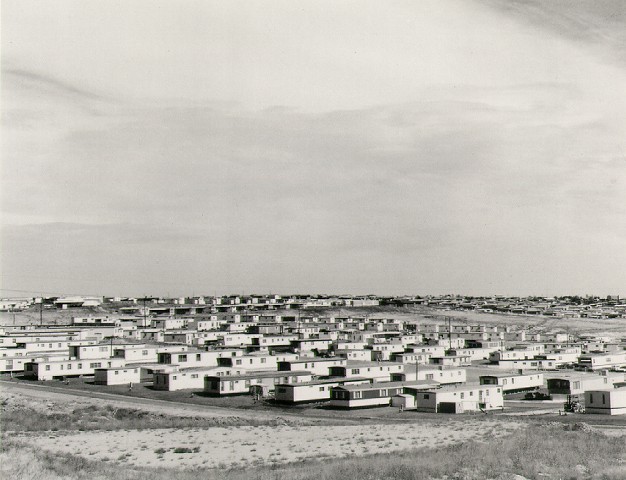
유명한 대표적 현대(1970년대) 풍경 사진가입니다.
많이 연구되어지기도 하고, 거론되기도 하고, 하여간 유명한 사진가입니다.
저 개인적으로는 별로 안 좋아합니다. 그러나 그의 작품을 직접 보게 된다면 생각이 달라질지도 모르겠네요.
위의 사진은 초기 작품(1970-74)과 요 근래 작품(1994년)을 올립니다.
Robert Adams (1937-)
Landscapes
Biography: ...Landscape seems to call upon us to be intimate with ourselves, as if to awaken in us pleasures, memories, or hopes that are not yet acculturated. The meaning of landscape is arguably bound up with an appeal to the illusion that within each of us lies something unshareable and not yet socialized. This is partly because of the ineffability of ungrasped sensation perceived in the far reaches of land under open air and partly because it still pleases North Americans to fantasize about nature not as culture and therefore not as a communal experience. Of course we know very well that the reserve into which we place our ideas of nature is a cultural reserve. But perhaps alone among the developed nations, we can still imagine our actual contact with nature to extend past that reserve, as if there were a frontier we hadn't yet transgressed. One photographer who knowingly works within that conflict between the imagined and the transgressed is Robert Adams.
Off the freeway near Colton, California, Adams climbed an eroded hillock. Fumes, haze, and effluents halate the otherwise graphically silhouetted black-and-white tones of photographs such as this and others he made for his book Los Angeles Spring. While the effects are redundant, the compositions are individually realized, each of them variants in an expanding poetic search. What Adams achieves is a poetry of depredation. In an era of landscape color, the black and white strikes a memorial note, and a curious mournfulness pervades scenes of an otherwise humdrum brutality. It's not that Adams appears to think tenderly of these undeserving views, but that in capturing them as moments of lonely experience he projects them back into a nineteenth-century landscape tradition and perceives their horizons as seemingly deserted now as they were then. A weariness of view fuses with the freshness of radiant seeing, as if Robert Frank's vision of a fifties America had blended with the imagery of Carleton Watkins's post-Civil War Yosemite. Adams shows withered eucalyptus trees, abandoned orange groves, and bulldozed, broken stretches of earth. Having earned his attention, they stay in mind as naturalized forms, lost to a process symbolized by the road or developers' trails.
In the introduction to The American Space: Meaning in Nineteenth-Century Landscape Photography, Adams writes, "Physically much of the land [the West] is almost as empty as it was when Jackson and Timothy O'Sullivan photographed there, but the beauty of the space-the sense that everything in it is alive and valuable-is gone." Adams considers the nineteenth-century photographers privileged because the clean skies they saw could illustrate the "opening verses of Genesis about light's part in giving form to the void." Their cameras could take their fill of scenes that are now obscured or faded out by an amorphous whiteness against which the reminiscent photographer now has to struggle to describe depth.
In Los Angeles Spring, that description and the conventionally nostalgic desire that went with it is foiled, leaving us to judge only unkempt things in the foreground. Deep space is equated with a past we cannot restore. Consequently, these recent images evoke a regret about the wealth of information steamed out in the light. They are comparative pictures.They imaginatively comprehend a span of events in which affection for nature must be misplaced if it is to have any object at all. (Max Kozloff - Lone Visions, CrowdedFrames)
출처 - http://www.profotos.com/education/referencedesk/masters/masters/robertadams/robertadams.shtml
http://www.masters-of-photography.com/A/adamsr/adamsr.html

풍경은 우리 스스로에게 친숙함을 불러일으킨다. 풍경의 의미는 우리
개개인 안에 공유될 수 없고 아직 사회화되지 않은 어떤 존재의 환영에
호소하는 것과 연결되어 있다. 이것은 열린 공간에서 먼곳으로 뻣어
있는 땅의 잡히지 않는 개념 때문이기고 하고 북아메리카는 아직
사회적으로 문화적으로 때묻지 않은 순수 그 자체라는 환상 때문이기도
하다. 산업화된 사회에 사는 우리는 아직까지 정복되지 않은 최전방의
자연의 존재와 접촉할 수 있다는 환상을 꿈꾼다. 정복된 자연과 상상의
자연 사이의 충돌안에서 작업을 하는 사진가가 로버트 아담스이다.
캘리포니아의 Colton 근처의 고속도로를 벗어난 아담스는 침식된 언덕을
올라갔다. 증기, 아지랭이, 폐수는 아담스의 책 LA의 봄("Los Angeles
Spring")을 위한 작업에서 찍혔던 것들처럼 실루엣의 흑백톤으로 처리되었다.
효과는 풍부하지만, 구성은 시적 연구의 확장으로 다양하고 개인적이다.
아담스가 성취한것은 약탈의 시이다. 칼라풍경사진 시대에 흑백은
추억을 환기 시키고 무미건조했을 장면에 음울함이 끼어들게 하고 있다.
이것은 아담스의 부적절한 시점(undeserving views)이 표현된것이 아니라
그가 19세기 풍경사진에 투영한 외로운 경험의 순간을 잡은것이며,
지평선들은 예전에 버려진 채로 있었던 그대로를 인식한것이다. 미국의
50년대에 대한 로버트 프랭크의 사진이 Carleton Watkins의 전후
요세미티에 대한 상상과 합쳐져 있는것처럼, 아담스의 관점은 빛나는
풍경의 신선함과 섞여있다. 아담스는 말라죽은 유칼립투스 나무,
버려진 오랜지색 글러브, 불도저, 땅의 갈라진틈 들을 보여주고 있다.
그의 주의를 끈것은 자연적인 형태 그래도 머물고 있는것들이며,
땅이나 개발자들의 자국에 의해서 상징화 단계를 잃어버린것들이다.
"The American Space: Meaning in Nineteenth-Centry Landscape
Photography"의 소개문에서 아담스는 다음과 같이 썼다: "땅[서부(The
West)]의 많은 부분이 잭슨과 티모시 설리반이 찍었던 것처럼 텅비어
있다. 그러나 공간의 아름다움-그 안에 존재하는 생동감과 가치들의
의미-는 사라졌다." 아담스는 19세기 사진가들이 보았던 맑은 하늘은
"빛이 무에 어떤 형태를 부여하는 창세기 시작절" 부분을 나타내기 때문에
그들이 특권을 누렸다고 생각한다. 과거를 회상하는 사진가들이 불명료하고
희미하게 사라져 가는 것들의 깊이를 표현하기 위해서 몸부림치는 무형의
순수함이 예전 사진가(19세기)들은 카메라에 채울수 있었다.
LA에서 봄은 일반적인 향수적 열망이나 묘사들을 사라지게 하고 우리에게
전경에 방치된 것들에 대한 판단을 남긴다.
깊은 공간감은 우리가 회복할 수 없는 과거와 같은것이다. 결과적으로 이
최근의 이미지들은 풍부했던 정보들이 빛안에서 흐려지는 것에 대한 후회이다.
그것들은 비교되는 사진들이다. 그것들은 만일 자연에 대한 애정이 어떤
목적을 가져야 한다면 잘못 되어진것이라는 상상적인 이해이다.